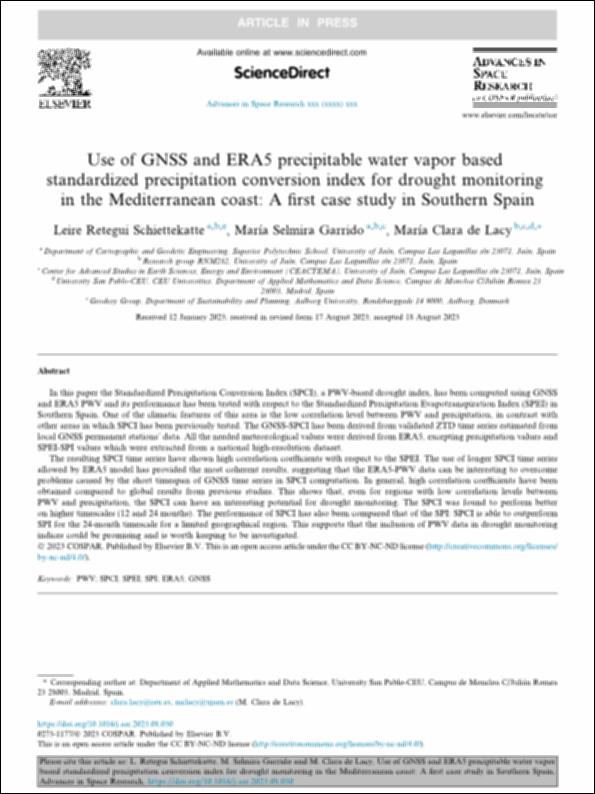Please use this identifier to cite or link to this item:
http://hdl.handle.net/10637/14580Use of GNSS and ERA5 Precipitable Water Vapor based Standardized Precipitation Conversion Index for drought monitoring in the Mediterranean coast: a first case study in Southern Spain
| Title: | Use of GNSS and ERA5 Precipitable Water Vapor based Standardized Precipitation Conversion Index for drought monitoring in the Mediterranean coast: a first case study in Southern Spain |
| Authors : | Retegui Schiettekatte, Leire Garrido-Carretero, María S. de Lacy Pérez de los Cobos, María Clara |
| Keywords: | Standardized Precipitation Conversion Index (SPCI); Precipitable Water Vapor |
| Publisher: | Elsevier |
| Citation: | L. Retegui Schiettekatte, M. Selmira Garrido and M. Clara de Lacy, Use of GNSS and ERA5 precipitable water vapor based standardized precipitation conversion index for drought monitoring in the Mediterranean coast: A first case study in Southern Spain, Advances in Space Research, https://doi.org/10.1016/j.asr.2023.08.030 |
| Abstract: | In this paper the Standardized Precipitation Conversion Index (SPCI), a PWV-based drought index, has been computed using GNSS and ERA5 PWV and its performance has been tested with respect to the Standardized Precipitation Evapotranspiration Index (SPEI) in Southern Spain. One of the climatic features of this area is the low correlation level between PWV and precipitation, in contrast with other areas in which SPCI has been previously tested. The GNSS-SPCI has been derived from validated ZTD time series estimated from local GNSS permanent stations’ data. All the needed meteorological values were derived from ERA5, excepting precipitation values and SPEI-SPI values which were extracted from a national high-resolution dataset. The resulting SPCI time series have shown high correlation coefficients with respect to the SPEI. The use of longer SPCI time series allowed by ERA5 model has provided the most coherent results, suggesting that the ERA5-PWV data can be interesting to overcome problems caused by the short timespan of GNSS time series in SPCI computation. In general, high correlation coefficients have been obtained compared to global results from previous studies. This shows that, even for regions with low correlation levels between PWV and precipitation, the SPCI can have an interesting potential for drought monitoring. The SPCI was found to perform better on higher timescales (12 and 24 months). The performance of SPCI has also been compared that of the SPI: SPCI is able to outperform SPI for the 24-month timescale for a limited geographical region. This supports that the inclusion of PWV data in drought monitoring indices could be promising and is worth keeping to be investigated |
| URI: | http://hdl.handle.net/10637/14580 |
| Rights : | http://creativecommons.org/licenses/by-nc-nd/4.0/deed.es OpenAccess |
| ISSN: | 0273-1177 |
| Supported by: | Acuerdo Transformativo - 2023 |
| Issue Date: | 23-Aug-2023 |
| Center : | Universidad San Pablo-CEU |
| Appears in Collections: | Facultad de Económicas y CC Empresariales |
Items in DSpace are protected by copyright, with all rights reserved, unless otherwise indicated.


